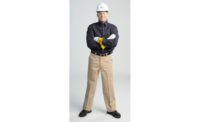The first few months of a new year provide an opportune time to review workplace safety initiatives to ensure your company is protecting its workers.
Now that flame resistant (FR), arc rated (AR) fabrics have lightweight and breathable performance features which can greatly benefit workers in the oil and gas industry, the first quarter is a good time to consider incorporating innovative FR/AR fabrics into your personal protective equipment (PPE) program. While there is no one-size-fits-all approach to conducting an annual review, use these five considerations to analyze if your FR/AR PPE program is ready for the coming year.
1) Are you using the latest consensus safety standards?
Each industry has relevant consensus standards that help govern the use of FR/AR apparel in the workplace. These standards are regularly reviewed and updated to reflect the very latest in test methods, risk assessments, and PPE best practices.
For protection against short-duration thermal hazards in the oil and gas industry, safety managers should reference NFPA 2112, the key standard on flame-resistant clothing, which was updated in 2018, and the recently released 2020 edition of NFPA 2113, standard on selection, care, use, and maintenance of FR clothing.
For protecting electricians working in the oil and gas industry, safety managers should consult the 2018 edition of NFPA 70E.
New PPE-related updates to these standards include incorporating FR/AR outerwear, hoods, and gloves to NFPA 2112 and 2113 and accounting for human error in NFPA 70E which enhance PPE best practice procedures.
Review the latest editions to ensure you are adhering to the necessary requirements to protect employees. If a company fails to update its safety practices to reflect the latest editions of consensus standards, it may be subject to OSHA sanctions, in addition to putting employees at risk of potentially life-threatening injuries.
2) Is your risk assessment current?
To accurately guard against workplace hazards, performing a risk assessment will determine the occupational hazards employees may face, which help guide FR/AR PPE selection. Without fully understanding workplace risks, an FR/AR PPE program may provide incomplete protection and endanger employees should an unexpected flash fire or arc flash occur. It is important to conduct a risk assessment when new equipment or work procedures are implemented. Once the risk assessment is completed, reevaluate FR/AR PPE protocols to ensure they meet the minimum workplace requirements to fully protect employees.
3) Are FR/AR garments in good condition?
Properly maintaining FR/AR PPE will help the garment retain its safety characteristics and perform as expected. This includes ensuring garments are in serviceable condition. If an FR/AR garment is missing buttons or has small holes, they may be able to be repaired; however, it is important to consult the garment manufacturer recommendations when considering mending a garment.
Garments with lingering stains or odors, large holes, or threadbare areas may be compromised, meaning they may not protect the wearer to the fullest extent should a flash fire or arc flash occur. It is important to inspect FR/AR garments before each use to ensure they are in wearable condition. If a garment is not in wearable condition, it is important to replace or repair it before wearing it again. Finally, outlining care and washing practices, such as avoiding bleach and fabric softeners, will help keep garments in serviceable condition.
4) Are FR/AR garments promoting a want-to-wear experience?
Part of ensuring employees are protected includes making sure they wear their FR/AR PPE throughout the day. A comfortable wear experience goes a long way in encouraging workers to wear their PPE. When employees are too hot or their garments are heavy or uncomfortable, they may need to take more frequent breaks or adjust their PPE throughout the day.
Small changes can be made to make workers more comfortable. For example, incorporating lightweight, performance FR/AR base layers can help reduce the impacts of heat stress and increase employee comfort with moisture-wicking and breathable features. Ensuring PPE meets wearer needs helps enhance the want-to-wear experience which, in turn, will help promote a well-maintained FR/AR PPE program.
5) Are employees wearing FR/AR garments correctly?
FR/AR PPE must be worn — and worn correctly — to provide the highest level of protection. Year-round education can help heighten overall compliance. When employees understand how and why they are wearing their PPE, they are more likely to comply with industry standards and workplace expectations. Hosting regular training sessions about properly wearing and caring for FR/AR PPE will help reduce the likelihood of an uninformed or complacent employee. In addition to implementing daily wear FR/AR programs—which can be instrumental in mitigating the risk of human error—emphasizing when and how task-based FR/AR PPE should be worn will help each employee understand how to properly and consistently protect themselves when working with known hazards.
Performing regular safety procedure reviews and updating FR/AR garment program initiatives is an important part of maintaining a well-rounded safety program to help keep employees protected against short-term thermal hazards.
FR/AR garments provide a final layer of defense against the life-threatening injuries from a flash fire or arc flash exposure and help keep a company compliant. The first few months of the year are an excellent time for a fresh start to ensure a well-designed, effective PPE program is in place to benefit the workplace.






